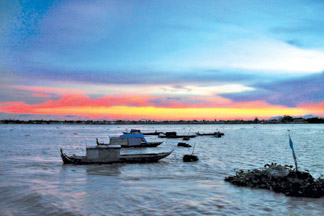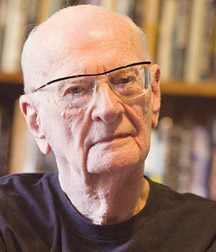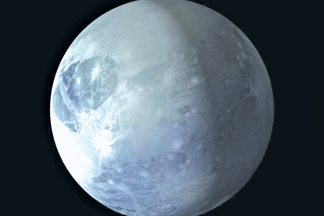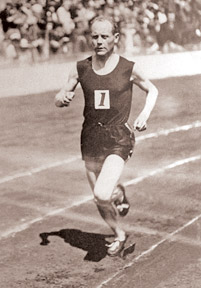
Pluto’s new identity
Nalaka GUNAWARDENE and Vindana ARIYAWANSA
The Solar System consists of our local star the
Sun and all the planetary bodies that are gravitationally bound in orbit
around it.
It includes eight planets, one dwarf planet,
over 140 moons orbiting the planets and thousands of other objects such
as asteroids
and comets. Among the planets, Mercury, Venus,
Mars, Jupiter and Saturn can all be seen by the naked eye and have been
known since the prehistoric times. The Modern Planets are those that
were discovered only after the invention of the telescope: Uranus
(1781), Neptune (1846) and Pluto (1930). In
2006, Pluto was reassigned to a new class of planets known as the dwarf
planets.
We start off today talking about Pluto which
has been in the news in recent years and gone through an identity
change,
dividing the global astronomical community in
the process
  1 A dwarf planet is a new term that astronomers adopted in 2006 as
part of a three-way categorization of bodies orbiting the Sun. The
International Astronomical Union (IAU) defines it as a celestial body
orbiting the Sun that is massive enough to be spherical as a result of
its own gravity but has not cleared its neighbouring region of
planetesimals (debris disks) and is not a satellite of any other body.
As of August 2011, IAU has recognized five dwarf planets in the solar
system. Which is the largest among them, also the ninth largest body to
orbit the Sun directly, and is estimated to be approximately 2,300 to
2,400 km in diameter (about a quarter of the Earth’s mass)? 1 A dwarf planet is a new term that astronomers adopted in 2006 as
part of a three-way categorization of bodies orbiting the Sun. The
International Astronomical Union (IAU) defines it as a celestial body
orbiting the Sun that is massive enough to be spherical as a result of
its own gravity but has not cleared its neighbouring region of
planetesimals (debris disks) and is not a satellite of any other body.
As of August 2011, IAU has recognized five dwarf planets in the solar
system. Which is the largest among them, also the ninth largest body to
orbit the Sun directly, and is estimated to be approximately 2,300 to
2,400 km in diameter (about a quarter of the Earth’s mass)?
2 The best known among dwarf planets, and the second largest as of
August 2011, is Pluto. From its discovery in 1930 until 2006, Pluto was
classified as a planet – the ninth and furthest planet from the Sun in
the Solar System. In August 2006, International Astronomical Union (IAU)
redefined what it meant to be a planet. Since Pluto met only two of the
three criteria to be recognized as a planet, it was reclassified as a
dwarf planet – in other words, a demotion in status! This was a
controversial decision which has drawn both support and criticism from
different astronomers, but has remained in use. Name the American
astronomer who originally discovered Pluto in 1930.
3 For nearly half a century after its discovery, Pluto was not known
to have any satellites or ‘moons’. This changed in 1978 with the
discovery of Charon. For a while afterwards, Pluto and Charon were
called a double planet because Charon is larger compared to Pluto (has
half its diameter and an eighth of its mass) than any other moon is to a
planet in the Solar System. Since then, three more moons have been
discovered in orbit around Pluto, the latest on 28 June 2011:
provisionally named as S/2011 P1, it was found by the Hubble Space
Telescope’s Pluto Companion Search Team. What names have been given to
the two outer satellites of Pluto, discovered also by the same team in
May 2005?
 4 A young Lankan film maker, Sanjeewa Pushpakumara, won the Best
Director award in the New Territories competition section of the Saint
Petersburg International Film Festival held in Russia in July 2011.
Sanjeewa won this award for his maiden feature film which has three
parallel stories set amidst the war in an Eastern village. What is the
title of the film? 4 A young Lankan film maker, Sanjeewa Pushpakumara, won the Best
Director award in the New Territories competition section of the Saint
Petersburg International Film Festival held in Russia in July 2011.
Sanjeewa won this award for his maiden feature film which has three
parallel stories set amidst the war in an Eastern village. What is the
title of the film?
5 The Last Theorem was the last novel by the late Sir Arthur C
Clarke. He started writing it in 2003 as a solo effort, but later
invited and involved an accomplished American science fiction writer as
collaborator to help complete the novel which by then had been
completely planned out. This co-author completed the final manuscript
which was approved by Clarke only a few days before his death in March
2008 aged 90. The Last Theorem was published in August 2008. Who was the
co-author?
 6 Located in Southeast Asia, it is a small country of 15,410 square
km. It was colonized by Portugal in the 16th century, and remained a
Portuguese colony until 1975. That year, the country declared its
independence, but was soon invaded and occupied by Indonesia which
declared it as its 27th province. In 1999, following a long negotiation
by the United Nations, Indonesia gave up its occupation and control of
the territory became the first new sovereign state of the 21st century
on 20 May 2002. It is still the youngest nation state in Asia, and one
of only two predominantly Roman Catholic countries in Asia (the other
being the Philippines). Can you identify this country? 6 Located in Southeast Asia, it is a small country of 15,410 square
km. It was colonized by Portugal in the 16th century, and remained a
Portuguese colony until 1975. That year, the country declared its
independence, but was soon invaded and occupied by Indonesia which
declared it as its 27th province. In 1999, following a long negotiation
by the United Nations, Indonesia gave up its occupation and control of
the territory became the first new sovereign state of the 21st century
on 20 May 2002. It is still the youngest nation state in Asia, and one
of only two predominantly Roman Catholic countries in Asia (the other
being the Philippines). Can you identify this country?
7 Established in 1828, this is amongst the oldest French perfume
houses. The success of the company under Pierre-Francois peaked in 1853
with the creation of Eau de Cologne Imeperiale, making him the French
Emperor’s Official Perfumer. This led him to also create perfumes for
Queen Victoria of England and Queen Isabella II of Spain. Famous
fragrances of the 20th Century produced by this company include
Mitsuoko, Shalimar and Samsara. This was the first house to launch
lipstick in a bullet shaped container. What is this iconic perfume
house?
8 The word ‘Quarantine’ means enforced isolation to prevent the
spread of something considered dangerous and contagious. The word stems
from the 14th Century recognition that plague was brought by ships
returning from the eastern Mediterranean. Venice decreed that ships were
to be isolated for a limited period to allow for the manifestation of
the disease and to dissipate the infection brought by persons or goods.
The word ‘quarantine’ is derived from Italian quaranta giorni, which
indicates the number of days ships had to be isolated. How many days?
 9 Born in 1982 in South Korea, he is one of Asia’s most popular
singers, known for his work pop and R&B genres. He is also a dancer,
model and actor. He had a lead role in Chan Wook Park’s movie I’m a
Cyborg, But That’s OK (2006) and has also acted in the US movies Speed
Racer (2008) and Ninja Assassin (2009). His popularity with fans was
evident from the fact that he took the top spot in the TIME Magazine’s
Power 100 online reader poll for the third year in 2011. His birth name
is Jung Ji-hoon, but he is better known by what stage name? 9 Born in 1982 in South Korea, he is one of Asia’s most popular
singers, known for his work pop and R&B genres. He is also a dancer,
model and actor. He had a lead role in Chan Wook Park’s movie I’m a
Cyborg, But That’s OK (2006) and has also acted in the US movies Speed
Racer (2008) and Ninja Assassin (2009). His popularity with fans was
evident from the fact that he took the top spot in the TIME Magazine’s
Power 100 online reader poll for the third year in 2011. His birth name
is Jung Ji-hoon, but he is better known by what stage name?
10 The Central Bank of Ceylon (now Central Bank of Sri Lanka) was
established in 1950 and is responsible for the country’s monetary policy
and also has wide supervisory powers over the financial system. The
first head of the Central Bank, known as Governor, was an American
economist who was a member of the Board of Governors of the United
States Federal Reserve System. Who was he?
11 The ‘Digital television transition’ is the process in which analog
television broadcasting is converted to and replaced by digital
television. This involves both TV stations and the viewers who need to
change their TV receivers. Over a dozen industrialised countries have
already completed this transition while many other countries are phasing
out analog broadcasting and have set deadlines for completing it. On 24
July 2011, which became the first Asian country to switchover to digital
TV broadcasting?
12 The tenth longest river in the world, it is over 4,900 km long. It
originates in the Tibetan Plateau in China, and runs through China’s
Yunan Province, Burma, Laos, Thailand, Cambodia and Vietnam. Some
important cities in Southeast Asia are located along its path, including
Vientiane (capital of Laos) and Phnom Penh (capital of Cambodia). This
river plays a major role in sustaining the farming and inland fisheries.
What is its name?
 13 The stories of her first Oscar award as best actress for
Butterfield 8 (1960) have grown legendary. It is now widely accepted
that she won over the Academy’s members that year by a vote of sympathy,
because of the recent death of her husband, Michael Todd, and her
near-fatal illness and emergency tracheotomy to save her life (her scar
was very visible on that year’s Oscar night). Wisecracker and Rat Pack
member Shirley MacLaine, who was favoured to win for her role in The
Apartment (1960), said afterwards that “I lost out to a tracheotomy.”
Name this accomplished Hollywood actress, who won a second Oscar for
best actress in 1966 for Who’s afraid of Virginia Woolf? 13 The stories of her first Oscar award as best actress for
Butterfield 8 (1960) have grown legendary. It is now widely accepted
that she won over the Academy’s members that year by a vote of sympathy,
because of the recent death of her husband, Michael Todd, and her
near-fatal illness and emergency tracheotomy to save her life (her scar
was very visible on that year’s Oscar night). Wisecracker and Rat Pack
member Shirley MacLaine, who was favoured to win for her role in The
Apartment (1960), said afterwards that “I lost out to a tracheotomy.”
Name this accomplished Hollywood actress, who won a second Oscar for
best actress in 1966 for Who’s afraid of Virginia Woolf?
14 In the three summer Olympic Games held during the 1920s, one man
seemed to stand out from the rest. He ran both middle and long distance.
In 1920, he won three gold medals. In 1924, he won five. In 1928, he won
one. He also took three silver medals. Known in his time as The Flying
Finn, who was he?
15 Whom did Mohammad Ali fight in order to regain the World
Heavyweight boxing Championship in Kinshasa, Zaire, in 1974? This fight
was known as the ‘Rumble in the Jungle’ and it was orchestrated by
controversial boxing promoter Don King. Ali won by knocking out his
opponent in the eighth round.
Answers will be published next week.
Last week’s answers
1. Robben Island
2. Nelson Mandela was “Prisoner No 46664” during his 27 years as a
political prisoner
3. Frederik Willem de Klerk
4. Shahriar Mandanipour
5. Ronald Reagan, US President from 1982 to 1990
6. Diane Lane
7. Niger (followed by Mali and Uganda)
8. Kra Canal Project, also referred to as the Thai canal project
9. Hantane Kathawa
10. Dr Tom Gehrels (1925 - 2011)
11. Bob Hope (1903 – 2003)
12. Starbucks
13. Ravi Shankar
14. Symbolics.com
15. Douglas Jardine |



